Six years after 2010 summer triggered Kashmir’s new age militancy, killing of a young rebel stirred up another summer of dissenting and bloodletting. With Omar advising successor Mehbooba against stepping into his shoes, it seems old wisdom is at play in managing the ongoing turmoil, reports Bilal Handoo
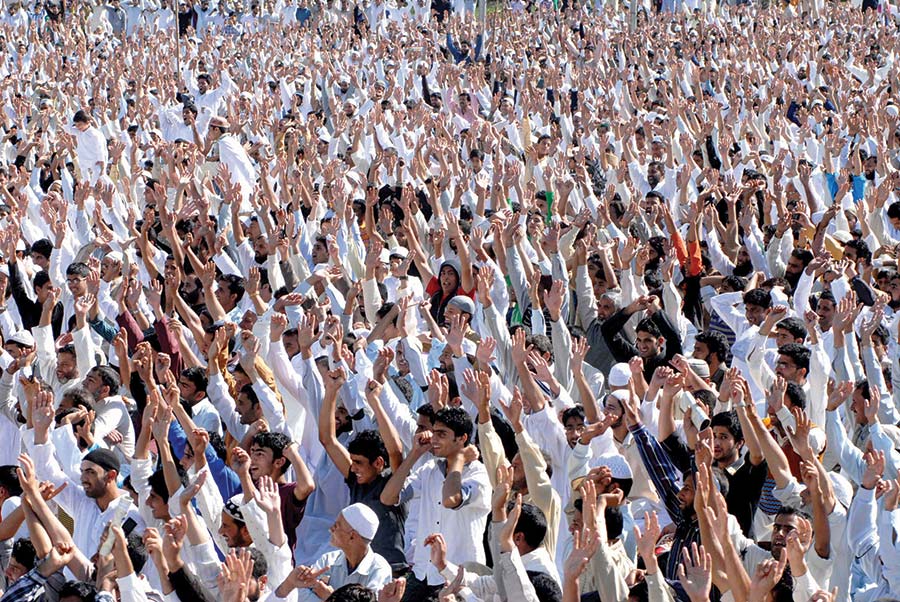
That giant rally in summer 2008 having 500,000 plus dissenters made it a “sentimental sea” of strength. Described as the defining moment in Kashmir’s post-ninety rebellion, that huge human assembly at Srinagar’s Eidgarh saw peoples’ hostility taking shape of the substantial street strife.
Those days, a dispute over 99 acre Amarnath land for Hindu shrine had revived vintage war cry for freedom in valley. Shortly, Delhi’s hunky dory theory of Kashmir was scoffed at — despite puny militancy, marginal Hurriyat and booming tourism.
“That was a people’s movement,” says Yasin Malik, JKLF chief, then threatening to fast unto death if the land order wouldn’t be revoked. “It was a shift to non-violent means from armed struggle.” With everyone coming together to challenge Delhi’s rule in post-9/11 era Kashmir, the Genext went ballistic, expressing uninhibited political expression on streets. For two nuke neighbours already done fighting three wars over Kashmir, the summer upheaval only strained the uneasy ties despite 2004 olive branch.
As ragda, ragda became Kashmir’s new dance of defiance, the unionists termed it a failure in engaging people. Shortly Islamabad reacted. It supported the protesters, prompting irked but traditional response from Delhi: “There is a Pakistani hand behind the unrest.” But on Kashmir streets, Delhi’s “Pak hand” theory had long become a subject of ridicule.
“That summer,” says a scholar, Waseem Bhat, part of 2008 protests, “Amarnath land row was just a trigger. It was a long awaited moment to revolt against years of security onslaught and long denial of freedom. It was the summer of our discontent.”
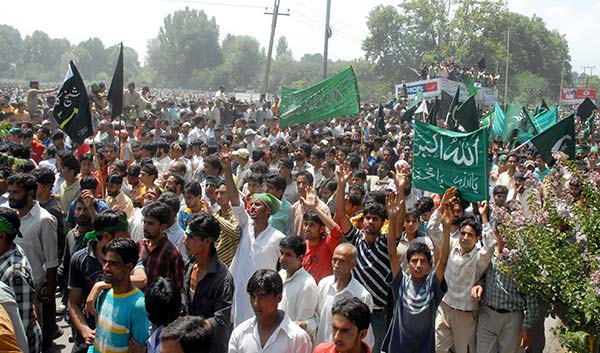
On June 23, 2008, the first protests against the controversial land transfer broke out in downtown Srinagar. A JKLF (R) leader part of the protest saw CRPF opening fire on protesters at Nowhatta, killing one person, wounding 40 others. “It never stopped after that,” says the leader, still making rounds of court for his participation. “It was a beginning of our new struggle, new dissent. That summer weaponised us to fight for our justice, honour and freedom.” With Hyderpora, Maisuma and Nigeen giving wake-up calls to Kashmiris over the land transfer, the besieged city and elsewhere took to roads in rage.
Amid protests, Congress-led government clarified only washrooms and shelters for devotees were to be built on the land. But people and Hurriyat leaders compared the move to Israeli settlements in West Bank. Even Congress’ alliance partner, PDP, threatened to desert the coalition if the land transfer agreement wouldn’t be revoked. This prompted authorities to scrap the plan. The decision, in turn, sparked protests in Jammu — J&K’s only Hindu-majority city.
Despite revoking the land transfer, the crisis deepened further. PDP didn’t lend support to state government, forcing Ghulam Nabi Azad’s minority government to step-down on July 7, 2008. By then, the media had exposed PDP’s “political gimmick”—as the party’s forest minister, Qazi Afzal, was proven to be final authority behind the contentious land transfer.
BJP was keeping Jammu on boil over revocation order and emerged as main force behind the economic blockade. Kashmiri traders threatened to export their products via Muzaffarabad and Wagah border. That summer sent home a troupe of blinded Kashmiri truckers, rendered sightless in lynch-mob attacks on highway.
In valley, the casualty was rising. For attempting to cross LoC, forces killed fifteen people, wounding hundreds on August 11. As protests intensified, gunners even opened fire on a protest rally led by ex-minister Javed Mustafa Mir in Lasjan, killing four protesters.
Amid bloodbath, the Amarnath agitation ended on August 31, 2008, following signing of an agreement between protesters and governor-appointed panel. Under the agreement, the shrine board would be making temporary use of 40-hectares of land during the relevant yatra period.
But many in valley were left stunned after realising how Jammu dictated terms over their summer uprising.
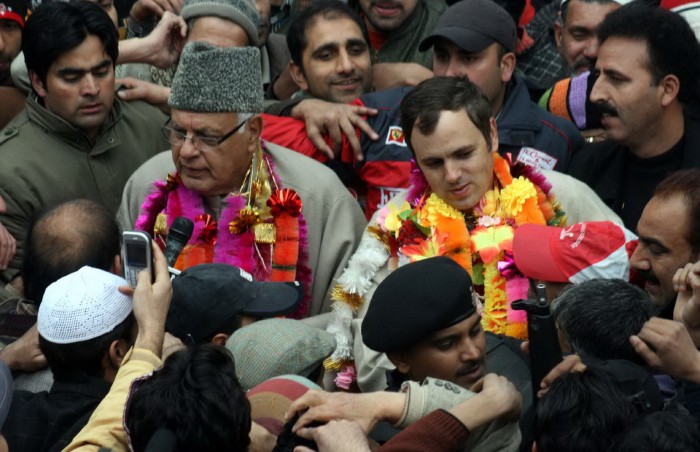
In later part of 2008, new government took over. The youngest chief minister Omar Abdullah was lauded as the “potential game changer”. The England-born Kashmir top executive promised an era of reconciliation, zero human rights tolerance, gradual demilitarisation, repeal of contentious AFSPA, restricting use draconian PSA and even setting up of Truth and Reconciliation Commission. But his first spring as J&K CM coincided with Shopian double murder case, triggering a 47-day protest shutdown in Shopian. While an autopsy report confirmed rape of the two sister-in-laws, the government appointed one-man commission held four police officers responsible for destroying evidence.
As Kashmir revolted, Delhi called CBI for a fresh probe. Its findings only created resentments. It concluded that the women died of drowning in a knee-height brook! CBI then filed cases against doctors involved in previous probes and lawyers fighting the case. They were charged for inciting violence. This triggered massive loath. Before Kashmir would rage up again, a lull period ensued, marked with periodic killings.
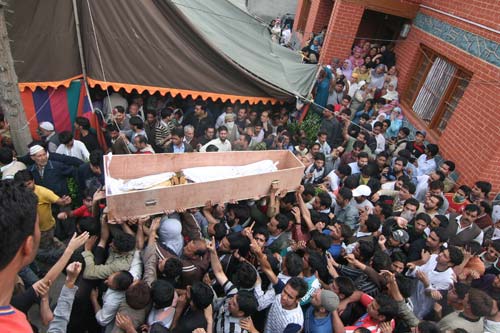
Next year in June, army’s claims to have gunned down three “Pakistani infiltrators” at Machil were seriously contested. It didn’t take Kashmir much time to learn that it was a fake encounter case in which a soldier, a counter-insurgent and an ex-special police officer had lured three young men from Baramulla’s Nadihal village and killed them in a staged encounter at Sona Pindi.
“Almost every encounter now has a question mark,” CM Omar reacted. “Army is the judge, jury and the hangman. There’s absence of transparency, as a result of which people have lost faith in the system.” Omar’s assertions found resonance in those families whose sons were long subjected to enforced disappearances. “One can say,” says Khurram Parvez, a rights activist, and one of the persons to unearth mass graves in Kashmir, “the Machil was the reaffirmation of the belief how army, paramilitary or police would kill innocent Kashmiris in fake encounters and passed them as militants. What happened at Machil left nothing unsaid for imagination and therefore became a flashpoint.”
Shortly cops shot death teenager Tufail Mattoo in Old Srinagar, triggering the uprising. With Hurriyat batting for demilitarized Kashmir, youth raising pro-freedom slogans defied curfews and attacked forces with stones. Many chipped in with creative protests: graffiti, music, poetry, dramas. The artistic touch made the protests novel and perhaps, far-reaching on soon-to-be banned internet. But defiant streets had their own idea to engage the state.
To contain street defiance, police purchased new age “non-lethal” weaponry—Tasers, pellet, peppers, stun guns and laser dazzlers—mainly from Defence Research and Development Organization (DRDO) with Rs 30 crore funds allocated by Delhi. But despite using these “non-lethal” firearms, police and paramilitary still managed to pile up 123 bodies in that summer, and wounding hundreds.
Before Amnesty International could dictate Indian forces to stop using gunfire against protesters, PM Manmohan Singh asked for revisiting operating procedures. He right away tasked his economic adviser C Rangarajan to find economic solution to the political problem!
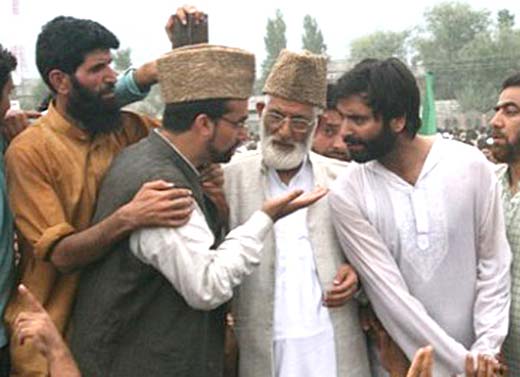
For a change, Delhi proposed all-party meeting in troubled Kashmir. Saying that dialogue was the only way to find lasting peace, it sent invitations to Mirwaiz Umar Farooq and Yasin Malik — earlier excluded from 2008 all-party meeting in wake of Amarnath land row.
Later that fall, the 39-member delegation including home minister P Chidambaram arrived in valley, apparently to defuse the tensions. On the day of their arrival, three young men succumbed to their bullet-wounds in hospitals, while troopers shot dead a woman in Sopore.
Amid killings, the delegation announced measures: release of students, reopening of schools, debate on demilitarisation, reviewing of areas designated as disturbed and appointment of interlocutors. They even announced “blood money” of Rs 5 lac to the families of those killed in summer protests. Not everyone accepted that.
Then the caged Hurriyat presented its demands. Among his five preconditions for official dialogue, Syed Ali Geelani called for a ban on shooting on anti-establishment demos, release of political prisoners, official acknowledgement of Kashmir dispute and others. Mirwaiz Umar Farooq demanded constitution of Indo-Pak parliamentary committees for final settlement of disputed Kashmir. Yasin Malik demanded that Hurriyat be made a part of Kashmir-specific Indo-Pak dialogue process.
But Delhi, says Mirwaiz, never honoured Hurriyat’s demands. “The only time they show some interest in Kashmir is when it is burning,” the cleric says. “And they only engage Hurriyat when killings, protests and peace of graveyard grip valley.”
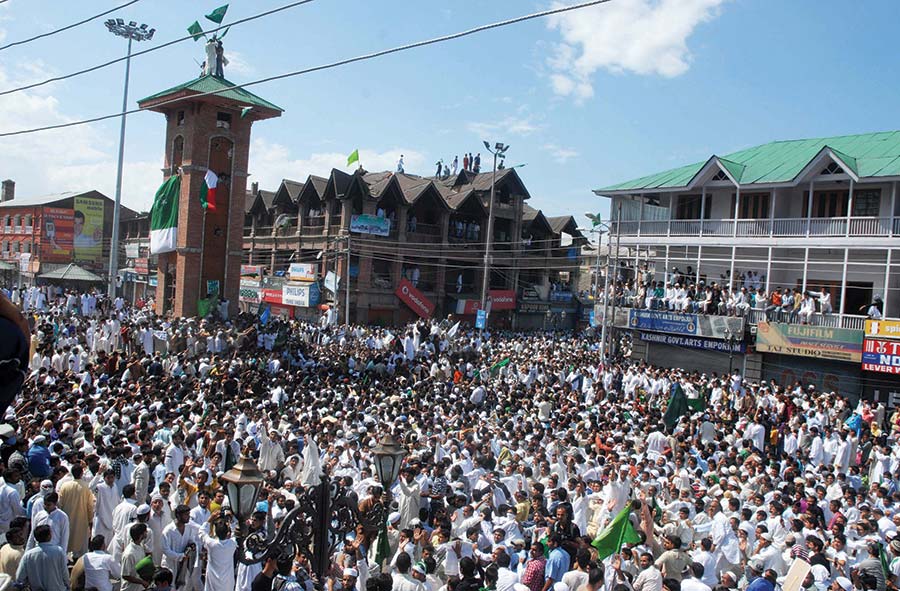
That summer the third-generation Abdullah had even called army to restore street calm. He banned text messages and internet to cut size Kashmir’s virtual dissent. “I’ve had better days, but I’ve had worse, too,” Abdullah said in an interview inside his well-guarded Gupkar mansion. “That’s why they say chief minister of Kashmir is one of the toughest jobs in the country.” With Delhi’s assistance, Omar at fag end of 2010 put together an action plan.
“The main idea was to keep Kashmiri youth away from streets,” says Dr Sheikh Mustafa Kamaal, NC veteran and Omar’s uncle. “Maintaining peace was paramount to us. In absence of it, nothing could have been achieved.”
The C Rangarajan panel appointed by PM Singh in August 2010 called for Rs 2,000 crore package to employ 40,000 people in five years. For imparting market-driven skills to 1 million Kashmiri youth, Himayat and Udaan schemes were launched. PM special scholarships were announced to benefit 25,000 students for five years. But most of these initiatives ran in rough weather over mismanagement and holdup funds.
“Already,” says Haleema, a distraught wife of a Kashmiri trucker blinded on highway near Samba during 2008 Amarnath land row, “my son has been sent home six times in last three years over fees.” Her only son is pursuing B. Tech on PM scholarship in a Chandigarh-based college. “Last time, he told me in disgust: ‘I will pick up gun if they again send me home!’ ”
Despite backlash, Delhi sponsored recruitment drives for youth in paramilitary, police and army. MHA even sanctioned a special plan of Rs 104.09 crore to recruit Kashmiri youth in paramilitary. “When several youth queued up for such recruitment drives,” says a senior scribe, “it was read as the sign of change by unionists, pro-state activists and Delhi media—rather a clear desperation of educated youth to avail employment in a highly unemployed region.”
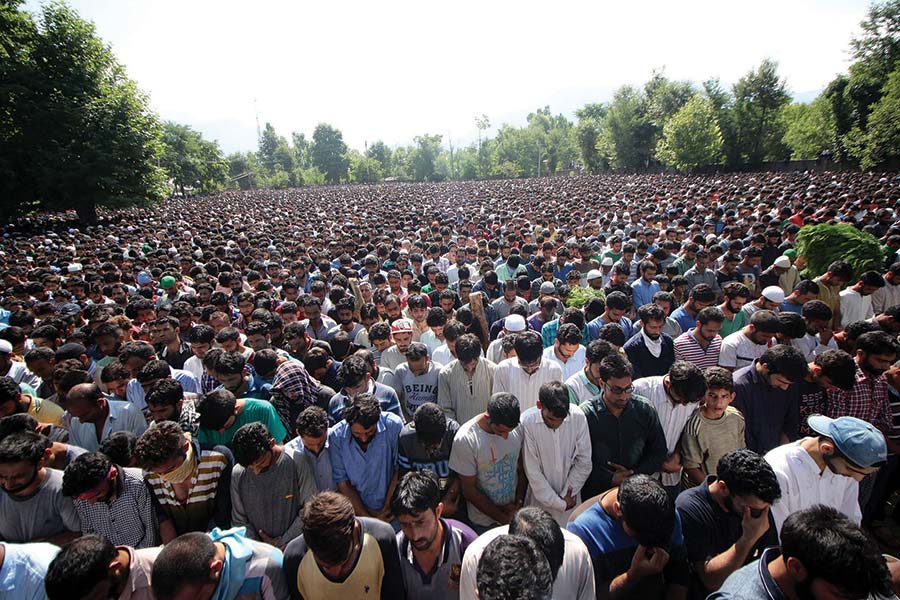
Apparently to prevent another summer uprising, police actively focussed on its civic action plan — organising counselling sessions and opening up youth clubs at various places. Quranic sessions for “misguided” youth were also held in police lockups.
“Suddenly, ‘Catch them Young’ doctrine involved everyone — from chief minister to army commander,” says a former SHO of Nowhatta police station. During his posting in restive Nowhatta area after 2010, the officer says, “I had clear orders from higher ups to undo the ‘radical’ mindset of stone pelters through religious reforms.”
So, did it work?
“Yes, it did—but, failed to achieve the desired end,” the officer says. “But that hardly discouraged us using other methods to reach out to youth and engage them.” Social media was one such engaging method.
But amid this self-styled squaring off, police was true to its traits — cracking whip on dissenters. No sooner the 2010 protests ended, police rounded up 4,294 persons. Around 200 of them including seven government employees and two minors were booked under lawless PSA. Over fifty government employees were detained, two of them dismissed from services over stone-pelting charges.
Further trailing the 2010 protests were nonstop nocturnal raids in valley’s “volatile” pockets and crackdown on resistance leadership. “To keep close eye on dissenters,” says one CID officer, “Kashmir became stronghold of sleuths and spies who raised their human intelligence network.” Cops even profiled families on pretext of Census exercise amid mushrooming of gawking CCTVs and surveillance towers. To “maintain law and order”, state went for complete re-verification of pre-paid mobile services after silencing them.

These measures touted as ‘defeat of dissent’ in valley apparently bred ‘politics of indifference’. Amid the stringent state management, even the interlocutors’ report was binned, thus setting off a sense: Delhi doesn’t want to learn its lessons in Kashmir. With its “ambitious” action plan gone haywire, the Kokernag killing only resurrected the old guards in valley.
Amid bloodletting, the chief minister of yore known for creating “carnage out of uprising” has already left a message for the present day unified command chief who was at forefront last summer condemning killings: “I feel that unfortunately, the lessons which we learnt in 2008 and 2010, the present government has forgotten them for some reasons.” Amid this political wordplay, the dawn of another summer has already made Hurriyat to declare it people’s movement they seem to have no control.
Youth being at the heart of the current uprising seems its ground managers. “People running over military installation clearly indicates that 2016 is fiercer than 2008, 2010,” says Khurram. “Intensity of the current uprising makes it appear like a battle for existence now, hence more lethal.”
With Delhi already acknowledging a tough task at hand, Pakistan’s “hyperactive” K-involvement has already triggered diplomatic tensions. Already the valley’s fiery countryside and equally fuming city are testing the “north pole-south pole alliance”, seemingly desperate to send normalcy signals around. Amid the midsummer discontent, the grapevine has it that Delhi might again try economic solution to the political problem.

But the uptight cleric climbing fence in protest these days has already made it known: “No economic largesse will lure this generation.” From Jamia Masjid pulpit last summer, miffed Mirwaiz had lashed out at Delhi’s doles: “We don’t want jobs, we don’t packages, we don’t want grants… We want?”
Thus came the thunderous chorus, already resonating in valley that summer: “Freedom!”
With old chorus reverberating again, this summer seems no different.















